Research of Parameters of a Compression Ignition Engine Using Various Fuel Mixtures of Hydrotreated Vegetable Oil (HVO) and Fatty Acid Esters (FAE)
Abstract
1. Introduction
2. Materials and Methods
2.1. Fuel Preparation
2.2. Experimental Setup, Experimental Procedure and Processing Experimental Data
3. Results
3.1. Combustion Characteristics
3.2. Energy Indicators
3.3. Ecological Indicators
4. Conclusions
- The use of fat esters results in a deterioration of their physical and chemical properties with increasing fat concentration. However, it is emphasized that the cetane number of pure fats is higher than compared with mineral diesel.
- One of the important advantages of testing mixtures is that it lowers the levels of harmful pollutants in the exhaust of diesel engines. One exception to this is oxides of nitrogen (NOx), which are implicated in ozone and smog formation.
- It was determined the D100 has a higher exhaust gas temperature in comparison with other mixtures due to the longer combustion process of the fossil fuel.
- We investigated whether when using blends, the combustion started earlier, in opposition to when using diesel fuel. The testing blends could give a positive impact on efficiencies (NOx-Soot trade-offs) and GHG, especially for a heavy-duty engine application. In addition, FE25, FE50, FE75 and FE100 blends reduced CO from approximately 7 to 13%. CO2 reduction was observed for all mixtures except FE75 and FE100. Additionally, the concentration of hydrocarbon emissions decreased for all mixtures. Lower values have HVO to compare with D100. Smoke emissions were also significantly lower for blends than for diesel. On average, HVO was reduced by ~18%, FE25 by ~47%, FE50 by ~55%, FE75 by ~58%, and FE100 by~62%. We have shown increased NOx emissions for all blends and fossil fuel with an increasing load.
- The brake thermal efficiency (BTE) indicators for the mixtures were lower compared to D100 for all loads, but for HVO, they were slightly higher than diesel (~0.5%). Considering that the heating values of the mixtures are lower in comparison with diesel fuel, it was found that the brake specific fuel consumption (BSFC) for all types of the mixtures was higher in opposition to fossil fuel, besides HVO, which has a higher LHV.
Author Contributions
Funding
Data Availability Statement
Acknowledgments
Conflicts of Interest
Abbreviations
| BTE | brake thermal efficiency |
| BSFC | brake specific fuel consumption |
| BMEP | Brake Mean Effective Pressure |
| CAD | crank angle degree |
| CO | Carbon monoxide |
| CO2 | Carbon dioxide |
| D | diesel fuel |
| ECU | electronic control unit |
| FE100 | fatty acid methyl ester from duck fat |
| FE25 | 25% fatty acid methyl ester derived from duck fat and 75% HVO |
| FE50 | 50% fatty acid methyl ester derived from duck fat and and 50% HVO |
| FE75 | 75% fatty acid methyl ester derived from duck fat and and 25% HVO |
| FAME | Fatty Acid Methyl Ester |
| HC | Unburned Hydrocarbons |
| HVO | Hydrotreated Vegetable Oils |
| MB | brake torque |
| CN | cetane number |
| ID | ignition delay |
| NOx | Nitrogen oxides |
| O2 | Oxygen |
| SOI | start of injection |
| SO2 | sulfur dioxide |
| LCV | lower calorific value |
| TDC | top dead center |
| WCO | waste cooking oil |
References
- Kosai, S.; Matsui, K.; Matsubae, K.; Yamasue, E.; Nagasaka, T. Natural Resource Use of Gasoline, Hybrid, Electric and Fuel Cell Vehicles Considering Land Disturbances. Resour. Conserv. Recycl. 2021, 166, 105256. [Google Scholar] [CrossRef]
- Zhao, Y.; Wang, C.; Zhang, L.; Chang, Y.; Hao, Y. Converting Waste Cooking Oil to Biodiesel in China: Environmental Impacts and Economic Feasibility. Renew. Sustain. Energy Rev. 2021, 140, 110661. [Google Scholar] [CrossRef]
- European Environment Agency. The European Environment: State and Outlook 2020: Knowledge for Transition to a Sustainable Europe; European Environment Agency: Luxembourg, 2019. [Google Scholar]
- Moustakidis, S. Renewable Energy—Recast to 2030 (RED II). Available online: https://ec.europa.eu/jrc/en/jec/renewable-energy-recast-2030-red-ii (accessed on 28 April 2021).
- Navas-Anguita, Z.; García-Gusano, D.; Iribarren, D. Long-Term Production Technology Mix of Alternative Fuels for Road Transport: A Focus on Spain. Energy Convers. Manag. 2020, 226, 113498. [Google Scholar] [CrossRef] [PubMed]
- Chong, C.T.; Loe, T.Y.; Wong, K.Y.; Ashokkumar, V.; Lam, S.S.; Chong, W.T.; Borrion, A.; Tian, B.; Ng, J.-H. Biodiesel Sustainability: The Global Impact of Potential Biodiesel Production on the Energy–Water–Food (EWF) Nexus. Environ. Technol. Innov. 2021, 22, 101408. [Google Scholar] [CrossRef]
- Athar, M.; Zaidi, S. A Review of the Feedstocks, Catalysts, and Intensification Techniques for Sustainable Biodiesel Production. J. Environ. Chem. Eng. 2020, 8, 104523. [Google Scholar] [CrossRef]
- Kim, M.; Won, W.; Kim, J. Integration of Carbon Capture and Sequestration and Renewable Resource Technologies for Sustainable Energy Supply in the Transportation Sector. Energy Convers. Manag. 2017, 143, 227–240. [Google Scholar] [CrossRef]
- CO2 Emissions from Fuel Combustion: Overview—Analysis. Available online: https://www.iea.org/reports/co2-emissions-from-fuel-combustion-overview (accessed on 28 April 2021).
- Fernbas National Energy and Climate Plans (NECPs). Available online: https://ec.europa.eu/energy/topics/energy-strategy/national-energy-climate-plans_en (accessed on 28 April 2021).
- Sgouridis, S.; Csala, D.; Bardi, U. The Sower’s Way: Quantifying the Narrowing Net-Energy Pathways to a Global Energy Transition. Environ. Res. Lett. 2016, 11, 094009. [Google Scholar] [CrossRef]
- Rohith Renish, R.; Amala Justus Selvam, M. A Critical Review on Production Process, Physicochemical Properties, Performance and Emission Characteristics of Sea Mango Biodiesel-Diesel Blends. Mater. Today Proc. 2021, 44, 2600–2605. [Google Scholar] [CrossRef]
- Duda, K.; Wierzbicki, S.; Śmieja, M.; Mikulski, M. Comparison of Performance and Emissions of a CRDI Diesel Engine Fuelled with Biodiesel of Different Origin. Fuel 2018, 212, 202–222. [Google Scholar] [CrossRef]
- Rimkus, A.; Vipartas, T.; Matijošius, J.; Stravinskas, S.; Kriaučiūnas, D. Study of Indicators of CI Engine Running on Conventional Diesel and Chicken Fat Mixtures Changing EGR. Appl. Sci. 2021, 11, 1411. [Google Scholar] [CrossRef]
- Zahan, K.A.; Kano, M. Technological Progress in Biodiesel Production: An Overview on Different Types of Reactors. Energy Procedia 2019, 156, 452–457. [Google Scholar] [CrossRef]
- Li, M.; Xu, J.; Xie, H.; Wang, Y. Transport Biofuels Technological Paradigm Based Conversion Approaches towards a Bio-Electric Energy Framework. Energy Convers. Manag. 2018, 172, 554–566. [Google Scholar] [CrossRef]
- Barua, P.; Hossain, N.; Chowdhury, T.; Chowdhury, H. Commercial Diesel Application Scenario and Potential of Alternative Biodiesel from Waste Chicken Skin in Bangladesh. Environ. Technol. Innov. 2020, 20, 101139. [Google Scholar] [CrossRef]
- Mahmudul, H.M.; Hagos, F.Y.; Mamat, R.; Adam, A.A.; Ishak, W.F.W.; Alenezi, R. Production, Characterization and Performance of Biodiesel as an Alternative Fuel in Diesel Engines—A Review. Renew. Sustain. Energy Rev. 2017, 72, 497–509. [Google Scholar] [CrossRef]
- Gorji, A. Animal Renewable Waste Resource as Catalyst in Biodiesel Production. J. Biodivers. Environ. Sci. 2015, 7, 2220–6663. [Google Scholar]
- Ramos, M.; Dias, A.P.S.; Puna, J.F.; Gomes, J.; Bordado, J.C. Biodiesel Production Processes and Sustainable Raw Materials. Energies 2019, 12, 4408. [Google Scholar] [CrossRef]
- Yesilyurt, M.K.; Cesur, C.; Aslan, V.; Yilbasi, Z. The Production of Biodiesel from Safflower (Carthamus tinctorius L.) Oil as a Potential Feedstock and Its Usage in Compression Ignition Engine: A Comprehensive Review. Renew. Sustain. Energy Rev. 2020, 119, 109574. [Google Scholar] [CrossRef]
- Islam, A. Biodiesel Production with Green Technologies; Springer Science + Business Media: New York, NY, USA, 2016; ISBN 978-3-319-45272-2. [Google Scholar]
- Kathirvel, S.; Layek, A.; Muthuraman, S. Exploration of Waste Cooking Oil Methyl Esters (WCOME) as Fuel in Compression Ignition Engines: A Critical Review. Eng. Sci. Technol. Int. J. 2016, 19, 1018–1026. [Google Scholar] [CrossRef]
- Vafakish, B.; Barari, M. Biodiesel Production by Transesterification of Tallow Fat Using Heterogeneous Catalysis. Kem. Ind. 2017, 66, 47–52. [Google Scholar] [CrossRef]
- Suarez-Bertoa, R.; Kousoulidou, M.; Clairotte, M.; Giechaskiel, B.; Nuottimäki, J.; Sarjovaara, T.; Lonza, L. Impact of HVO Blends on Modern Diesel Passenger Cars Emissions during Real World Operation. Fuel 2019, 235, 1427–1435. [Google Scholar] [CrossRef]
- Bereczky, A. Effect of the use of waste vegetable oil based biodiesel on the landscape in diesel engines. Therm. Sci. 2017, 21, 567–579. [Google Scholar] [CrossRef]
- Keskin, A.; Şen, M.; Emiroğlu, A.O. Experimental Studies on Biodiesel Production from Leather Industry Waste Fat and Its Effect on Diesel Engine Characteristics. Fuel 2020, 276, 118000. [Google Scholar] [CrossRef]
- Yesilyurt, M.K. The Evaluation of a Direct Injection Diesel Engine Operating with Waste Cooking Oil Biodiesel in Point of the Environmental and Enviroeconomic Aspects. Energy Sources Part Recovery Util. Environ. Eff. 2018, 40, 654–661. [Google Scholar] [CrossRef]
- Capuano, D.; Costa, M.; Di Fraia, S.; Massarotti, N.; Vanoli, L. Direct Use of Waste Vegetable Oil in Internal Combustion Engines. Renew. Sustain. Energy Rev. 2017, 69, 759–770. [Google Scholar] [CrossRef]
- Othman, M.F.; Adam, A.; Najafi, G.; Mamat, R. Green Fuel as Alternative Fuel for Diesel Engine: A Review. Renew. Sustain. Energy Rev. 2017, 80, 694–709. [Google Scholar] [CrossRef]
- Mahlia, T.M.I.; Syazmi, Z.A.H.S.; Mofijur, M.; Abas, A.E.P.; Bilad, M.R.; Ong, H.C.; Silitonga, A.S. Patent Landscape Review on Biodiesel Production: Technology Updates. Renew. Sustain. Energy Rev. 2020, 118, 109526. [Google Scholar] [CrossRef]
- Kończak, M.; Kukla, M.; Warguła, Ł.; Talaśka, K. Determination of the Vibration Emission Level for a Chipper with Combustion Engine. IOP Conf. Ser. Mater. Sci. Eng. 2020, 776, 012007. [Google Scholar] [CrossRef]
- Chen, Y.-A.; Liu, P.-W.G.; Whang, L.-M.; Wu, Y.-J.; Cheng, S.-S. Biodegradability and Microbial Community Investigation for Soil Contaminated with Diesel Blending with Biodiesel. Process Saf. Environ. Prot. 2019, 130, 115–125. [Google Scholar] [CrossRef]
- Islam, M.S.; Ahmed, A.S.; Islam, A.; Abdul Aziz, S.; Xian, L.C.; Mridha, M. Study on Emission and Performance of Diesel Engine Using Castor Biodiesel. J. Chem. 2014, 2014, 1–8. [Google Scholar] [CrossRef]
- Şen, M.; Emiroğlu, A.O.; Keskin, A. Production of Biodiesel from Broiler Chicken Rendering Fat and Investigation of Its Effects on Combustion, Performance, and Emissions of a Diesel Engine. Energy Fuels 2018, 32, 5209–5217. [Google Scholar] [CrossRef]
- Abdalla, I.E. Experimental Studies for the Thermo-Physiochemical Properties of Biodiesel and Its Blends and the Performance of Such Fuels in a Compression Ignition Engine. Fuel 2018, 212, 638–655. [Google Scholar] [CrossRef]
- Dhamodaran, G.; Krishnan, R.; Pochareddy, Y.K.; Pyarelal, H.M.; Sivasubramanian, H.; Ganeshram, A.K. A Comparative Study of Combustion, Emission, and Performance Characteristics of Rice-Bran-, Neem-, and Cottonseed-Oil Biodiesels with Varying Degree of Unsaturation. Fuel 2017, 187, 296–305. [Google Scholar] [CrossRef]
- Lewandowska, A.; Branowski, B.; Joachimiak-Lechman, K.; Kurczewski, P.; Selech, J.; Zablocki, M. Sustainable Design: A Case of Environmental and Cost Life Cycle Assessment of a Kitchen Designed for Seniors and Disabled People. Sustainability 2017, 9, 1329. [Google Scholar] [CrossRef]
- Fuc, P.; Lijewski, P.; Kurczewski, P.; Ziolkowski, A.; Dobrzynski, M. The Analysis of Fuel Consumption and Exhaust Emissions From Forklifts Fueled by Diesel Fuel and Liquefied Petroleum Gas (Lpg) Obtained under Real Driving Conditions. In Proceedings of the ASME International Mechanical Engineering Congress and Exposition, Tampa, FL, USA, 3–9 November 2017; Volume 6. [Google Scholar]
- Mikulski, M.; Ambrosewicz-Walacik, M.; Duda, K.; Hunicz, J. Performance and Emission Characterization of a Common-Rail Compression-Ignition Engine Fuelled with Ternary Mixtures of Rapeseed Oil, Pyrolytic Oil and Diesel. Renew. Energy 2020, 148, 739–755. [Google Scholar] [CrossRef]
- Rimkus, A.; Matijosius, J.; Bogdevicius, M.; Bereczky, A.; Torok, A. An Investigation of the Efficiency of Using O2 and H2 (Hydrooxile Gas-HHO) Gas Additives in a Ci Engine Operating on Diesel Fuel and Biodiesel. Energy 2018, 152, 640–651. [Google Scholar] [CrossRef]
- Emiroğlu, A.O.; Keskin, A.; Şen, M. Experimental Investigation of the Effects of Turkey Rendering Fat Biodiesel on Combustion, Performance and Exhaust Emissions of a Diesel Engine. Fuel 2018, 216, 266–273. [Google Scholar] [CrossRef]
- Skrzek, T.; Rucki, M.; Górski, K.; Matijošius, J.; Barta, D.; Caban, J.; Zarajczyk, J. Repeatability of High-Pressure Measurement in a Diesel Engine Test Bed. Sensors 2020, 20, 3478. [Google Scholar] [CrossRef]
- Górski, K.; Smigins, R.; Longwic, R. Research on Physico-Chemical Properties of Diethyl Ether/Linseed Oil Blends for the Use as Fuel in Diesel Engines. Energies 2020, 13, 6564. [Google Scholar] [CrossRef]
- Kirubakaran, M.; Arul Mozhi Selvan, V. A Comprehensive Review of Low Cost Biodiesel Production from Waste Chicken Fat. Renew. Sustain. Energy Rev. 2018, 82, 390–401. [Google Scholar] [CrossRef]
- Kinnal, N.; Sujaykumar, G.; D’costa, S.W.; Girishkumar, G.S. Investigation on Performance of Diesel Engine by Using Waste Chicken Fat Biodiesel. IOP Conf. Ser. Mater. Sci. Eng. 2018, 376, 012012. [Google Scholar] [CrossRef]
- Ramalingam, S.; Rajendran, S.; Ganesan, P.; Govindasamy, M. Effect of Operating Parameters and Antioxidant Additives with Biodiesels to Improve the Performance and Reducing the Emissions in a Compression Ignition Engine—A Review. Renew. Sustain. Energy Rev. 2018, 81, 775–788. [Google Scholar] [CrossRef]
- Vass, S.; Zöldy, M. Effects of Boundary Conditions on A Bosch-Type Injection Rate Meter. Transport 2021, 1–8. [Google Scholar] [CrossRef]
- Vass, S.; Zöldy, M. Detailed Model of a Common Rail Injector. Acta Univ. Sapientiae Electr. Mech. Eng. 2019, 11, 22–33. [Google Scholar] [CrossRef]
- Lijewski, P.; Merkisz, J.; Fuc, P.; Ziolkowski, A.; Rymaniak, L.; Kusiak, W. Fuel Consumption and Exhaust Emissions in the Process of Mechanized Timber Extraction and Transport. Eur. J. For. Res. 2017, 136, 153–160. [Google Scholar] [CrossRef]
- Andrzejewski, M.; Fuc, P.; Gallas, D.; Ziólkowski, A.; Daszkiewicz, P. Impact of driving style on the exhaust emission of a diesel multiple unit. In Computers in Railways XVII: Railway Engineering Design and Operation; WIT Press: Southampton, UK, 2020; pp. 365–376. [Google Scholar]
- Banković-Ilić, I.B.; Stojković, I.J.; Stamenković, O.S.; Veljkovic, V.B.; Hung, Y.-T. Waste Animal Fats as Feedstocks for Biodiesel Production. Renew. Sustain. Energy Rev. 2014, 32, 238–254. [Google Scholar] [CrossRef]
- Jayaprabakar, J.; Karthikeyan, A. Performance and Emission Characteristics of Rice Bran and Alga Biodiesel Blends in a CI Engine. Mater. Today Proc. 2016, 3, 2468–2474. [Google Scholar] [CrossRef]
- Mikulski, M.; Duda, K.; Wierzbicki, S. Performance and Emissions of a CRDI Diesel Engine Fuelled with Swine Lard Methyl Esters–Diesel Mixture. Fuel 2016, 164, 206–219. [Google Scholar] [CrossRef]
- Hirkude, J.B.; Padalkar, A.S. Performance and Emission Analysis of a Compression Ignition. Appl. Energy 2012, 90, 68–72. [Google Scholar] [CrossRef]
- Senthil Kumar, M.; Jaikumar, M. A Comprehensive Study on Performance, Emission and Combustion Behavior of a Compression Ignition Engine Fuelled with WCO (Waste Cooking Oil) Emulsion as Fuel. J. Energy Inst. 2014, 87, 263–271. [Google Scholar] [CrossRef]
- Işık, M.Z.; Bayındır, H.; İscan, B.; Aydın, H. The Effect of N-Butanol Additive on Low Load Combustion, Performance and Emissions of Biodiesel-Diesel Blend in a Heavy Duty Diesel Power Generator. J. Energy Inst. 2017, 90, 174–184. [Google Scholar] [CrossRef]
- Chuah, L.F.; Aziz, A.R.A.; Yusup, S.; Bokhari, A.; Klemeš, J.J.; Abdullah, M.Z. Performance and Emission of Diesel Engine Fuelled by Waste Cooking Oil Methyl Ester Derived from Palm Olein Using Hydrodynamic Cavitation. Clean Technol. Environ. Policy 2015, 17, 2229–2241. [Google Scholar] [CrossRef]
- Uyumaz, A. Combustion, Performance and Emission Characteristics of a DI Diesel Engine Fueled with Mustard Oil Biodiesel Fuel Blends at Different Engine Loads. Fuel 2018, 212, 256–267. [Google Scholar] [CrossRef]
- Gad, M.S.; Ismail, M.A. Effect of Waste Cooking Oil Biodiesel Blending with Gasoline and Kerosene on Diesel Engine Performance, Emissions and Combustion Characteristics. Process Saf. Environ. Prot. 2021, 149, 1–10. [Google Scholar] [CrossRef]
- Hwang, J.; Qi, D.; Jung, Y.; Bae, C. Effect of Injection Parameters on the Combustion and Emission Characteristics in a Common-Rail Direct Injection Diesel Engine Fueled with Waste Cooking Oil Biodiesel. Renew. Energy 2014, 63, 9–17. [Google Scholar] [CrossRef]
- Kegl, B.; Hribernik, A. Experimental Analysis of Injection Characteristics Using Biodiesel Fuel. Energy Fuels 2006, 20, 2239–2248. [Google Scholar] [CrossRef]
- Yadav, S.P.R.; Saravanan, C.G.; Kannan, M. Influence of Injection Timing on DI Diesel Engine Characteristics Fueled with Waste Transformer Oil. Alex. Eng. J. 2015, 54, 881–888. [Google Scholar] [CrossRef]
- Hunicz, J.; Matijošius, J.; Rimkus, A.; Kilikevičius, A.; Kordos, P.; Mikulski, M. Efficient Hydrotreated Vegetable Oil Combustion under Partially Premixed Conditions with Heavy Exhaust Gas Recirculation. Fuel 2020, 268, 117350. [Google Scholar] [CrossRef]
- Szabados, G.; Bereczky, Á. Experimental Investigation of Physicochemical Properties of Diesel, Biodiesel and TBK-Biodiesel Fuels and Combustion and Emission Analysis in CI Internal Combustion Engine. Renew. Energy 2018, 121, 568–578. [Google Scholar] [CrossRef]
- Ajtai, T.; Pinter, M.; Utry, N.; Kiss-Albert, G.; Gulyas, G.; Pusztai, P.; Puskas, R.; Bereczky, A.; Szabados, G.; Szabo, G.; et al. Characterisation of Diesel Particulate Emission from Engines Using Commercial Diesel and Biofuels. Atmos. Environ. 2016, 134, 109–120. [Google Scholar] [CrossRef]
- Kozak, M.; Lijewski, P.; Fuc, P. Exhaust Emissions from a City Bus Fuelled by Oxygenated Diesel Fuel; SAE International: Warrendale, PA, USA, 2020. [Google Scholar] [CrossRef]
- Warguła, Ł.; Krawiec, P.; Waluś, K.J.; Kukla, M. Fuel Consumption Test Results for a Self-Adaptive, Maintenance-Free Wood Chipper Drive Control System. Appl. Sci. 2020, 10, 2727. [Google Scholar] [CrossRef]
- Caban, J.; Droździel, P.; Ignaciuk, P.; Kordos, P. The impact of changing the fuel dose on chosen parameters of the diesel engine start-up process. Transp. Probl. 2019, 14, 51–62. [Google Scholar] [CrossRef]
- Sander, A.; Antonije Košćak, M.; Kosir, D.; Milosavljević, N.; Parlov Vuković, J.; Magić, L. The Influence of Animal Fat Type and Purification Conditions on Biodiesel Quality. Renew. Energy 2018, 118, 752–760. [Google Scholar] [CrossRef]
- Alptekin, E.; Canakci, M.; Ozsezen, A.N.; Turkcan, A.; Sanli, H. Using Waste Animal Fat Based Biodiesels–Bioethanol–Diesel Fuel Blends in a DI Diesel Engine. Fuel 2015, 157, 245–254. [Google Scholar] [CrossRef]
- Bereczky, A. The Past, Present and Future of the Training of Internal Combustion Engines at the Department of Energy Engineering of BME. In Vehicle and Automotive Engineering; Jarmai, K., Bollo, B., Eds.; Springer: Cham, Switzerland, 2017; pp. 225–234. [Google Scholar]
- Rimkus, A.; Stravinskas, S.; Matijošius, J. Comparative Study on the Energetic and Ecologic Parameters of Dual Fuels (Diesel–NG and HVO–Biogas) and Conventional Diesel Fuel in a CI Engine. Appl. Sci. 2020, 10, 359. [Google Scholar] [CrossRef]
- Marasri, S.; Ewphun, P.-P.; Srichai, P.; Charoenphonphanich, C.; Karin, P.; Tongroon, M.; Kosaka, H. Combustion Characteristics of Hydrotreated Vegetable Oil-Diesel Blends under EGR and Low Temperature Combustion Conditions. Int. J. Automot. Technol. 2019, 20, 569–578. [Google Scholar] [CrossRef]
- Dimitriadis, A.; Natsios, I.; Dimaratos, A.; Katsaounis, D.; Samaras, Z.; Bezergianni, S.; Lehto, K. Evaluation of a Hydrotreated Vegetable Oil (HVO) and Effects on Emissions of a Passenger Car Diesel Engine. Front. Mech. Eng. 2018, 4, 7. [Google Scholar] [CrossRef]
- Ghazikhani, M.; Ebrahim Feyz, M.; Mahian, O.; Sabazadeh, A. Effects of Altitude on the Soot Emission and Fuel Consumption of a Light-Duty Diesel Engine. Transport 2013, 28, 130–139. [Google Scholar] [CrossRef]
- Can, Ö. Combustion Characteristics, Performance and Exhaust Emissions of a Diesel Engine Fueled with a Waste Cooking Oil Biodiesel Mixture. Energy Convers. Manag. 2014, 87, 676–686. [Google Scholar] [CrossRef]
- Nantha Gopal, K.; Pal, A.; Sharma, S.; Samanchi, C.; Sathyanarayanan, K.; Elango, T. Investigation of Emissions and Combustion Characteristics of a CI Engine Fueled with Waste Cooking Oil Methyl Ester and Diesel Blends. Alex. Eng. J. 2014, 53, 281–287. [Google Scholar] [CrossRef]
- Satputaley, S.S.; Zodpe, D.B.; Deshpande, N.V. Performance, Combustion and Emission Study on CI Engine Using Microalgae Oil and Microalgae Oil Methyl Esters. J. Energy Inst. 2017, 90, 513–521. [Google Scholar] [CrossRef]
- Behçet, R.; Yumrutaş, R.; Oktay, H. Effects of Fuels Produced from Fish and Cooking Oils on Performance and Emissions of a Diesel Engine. Energy 2014, 71, 645–655. [Google Scholar] [CrossRef]
- Singh, D.; Singal, S.K.; Garg, M.O.; Maiti, P.; Mishra, S.; Ghosh, P.K. Transient Performance and Emission Characteristics of a Heavy-Duty Diesel Engine Fuelled with Microalga Chlorella Variabilis and Jatropha Curcas Biodiesels. Energy Convers. Manag. 2015, 106, 892–900. [Google Scholar] [CrossRef]
- Gumus, M.; Kasifoglu, S. Performance and Emission Evaluation of a Compression Ignition Engine Using a Biodiesel (Apricot Seed Kernel Oil Methyl Ester) and its Blends with Diesel Fuel. Biomass Bioenergy 2010, 34, 134–139. [Google Scholar] [CrossRef]
- Rimkus, A.; Žaglinskis, J.; Rapalis, P.; Skačkauskas, P. Research on the Combustion, Energy and Emission Parameters of Diesel Fuel and a Biomass-to-Liquid (BTL) Fuel Blend in a Compression-Ignition Engine. Energy Convers. Manag. 2015, 106, 1109–1117. [Google Scholar] [CrossRef]
- Anis, S.; Budiandono, G.N. Investigation of the Effects of Preheating Temperature of Biodiesel-Diesel Fuel Blends on Spray Characteristics and Injection Pump Performances. Renew. Energy 2019, 140, 274–280. [Google Scholar] [CrossRef]
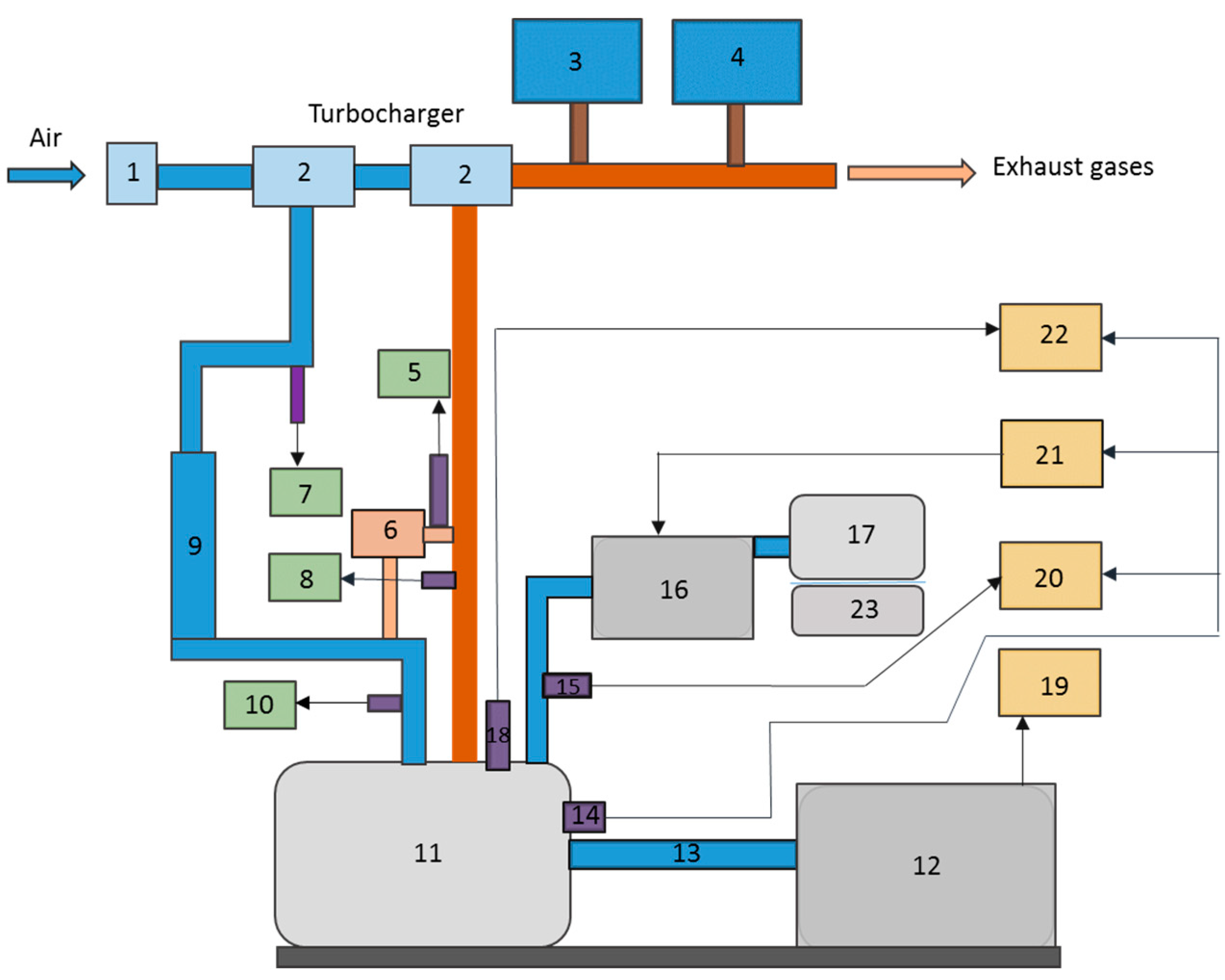
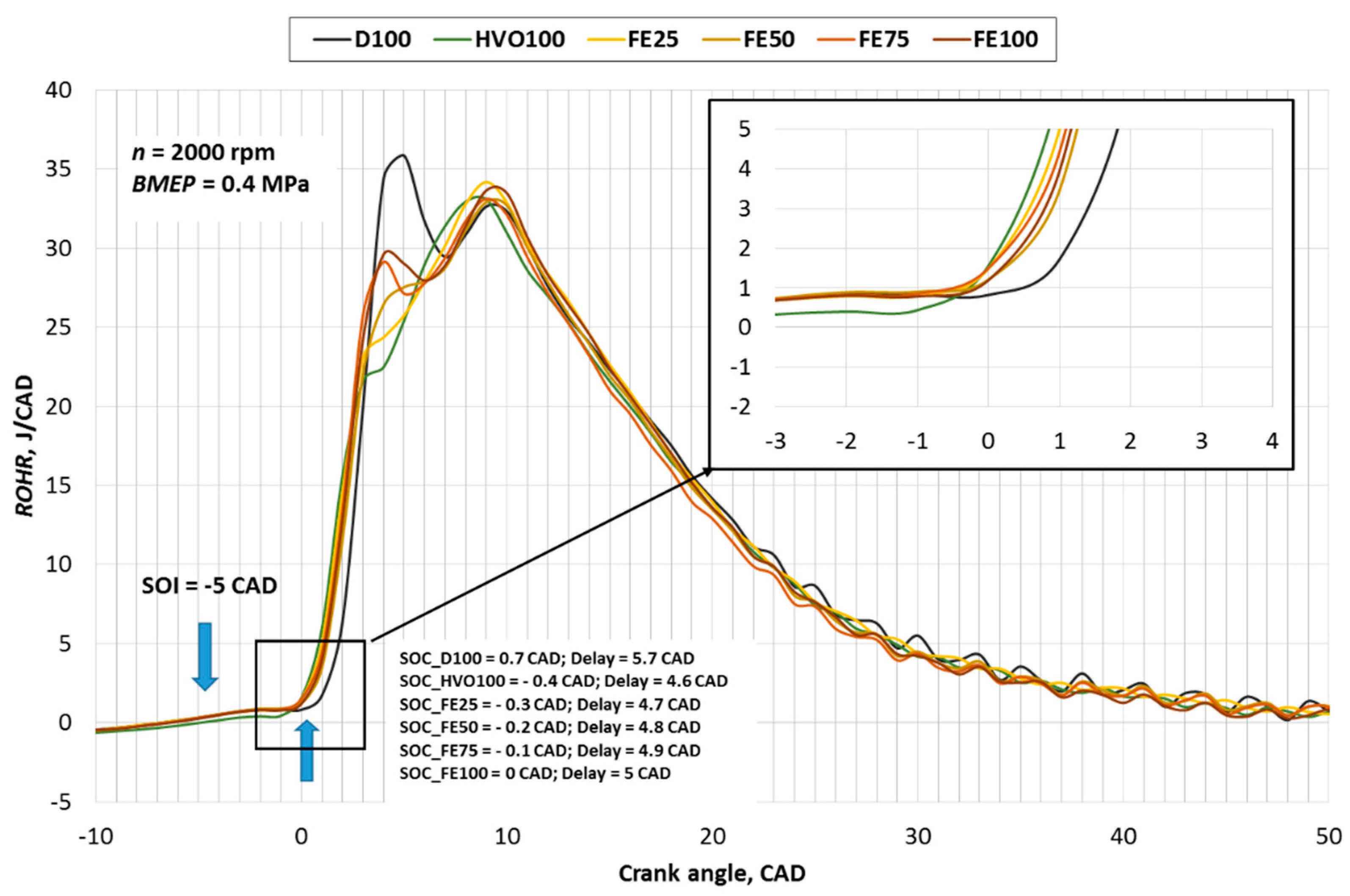
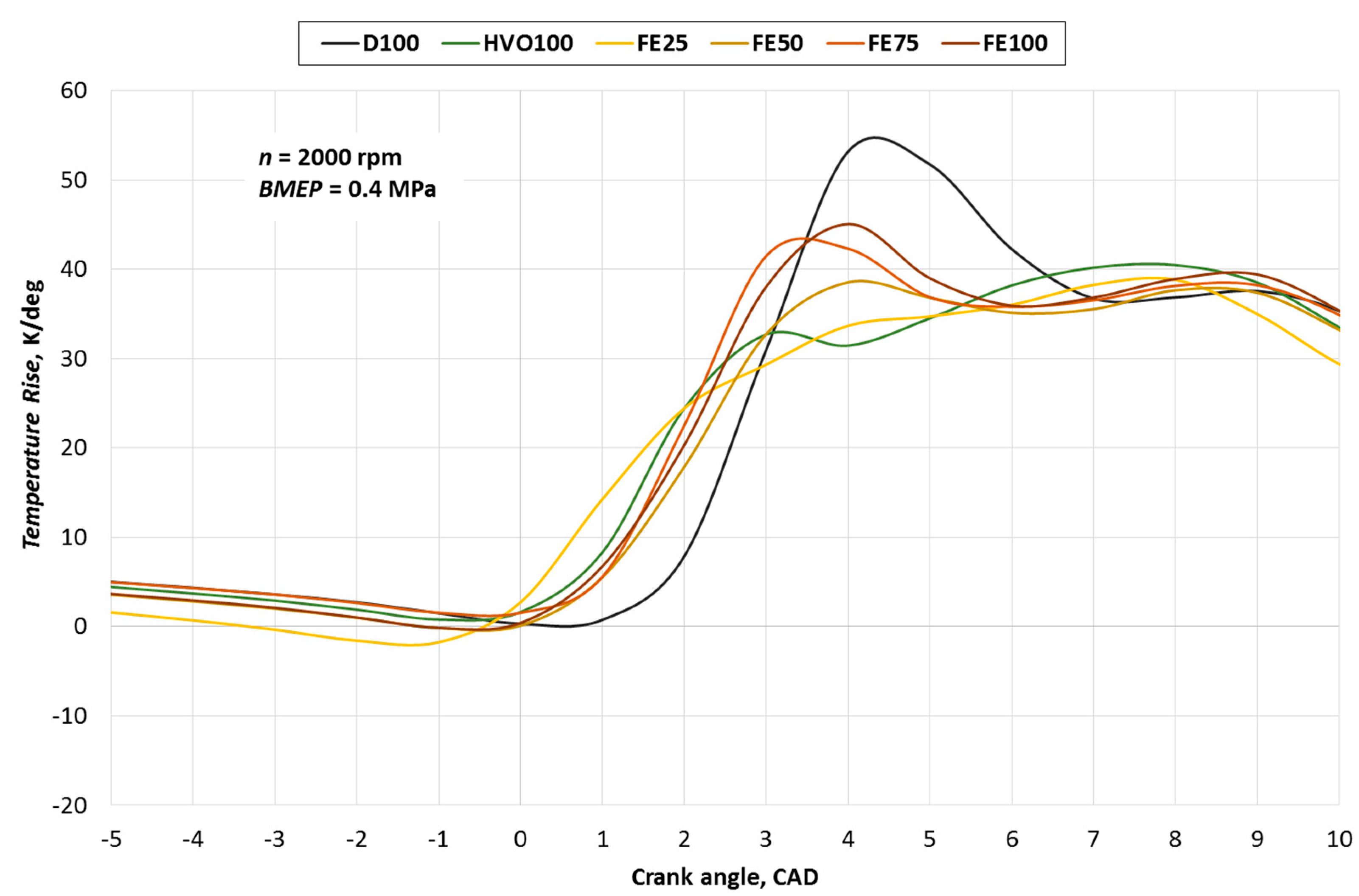

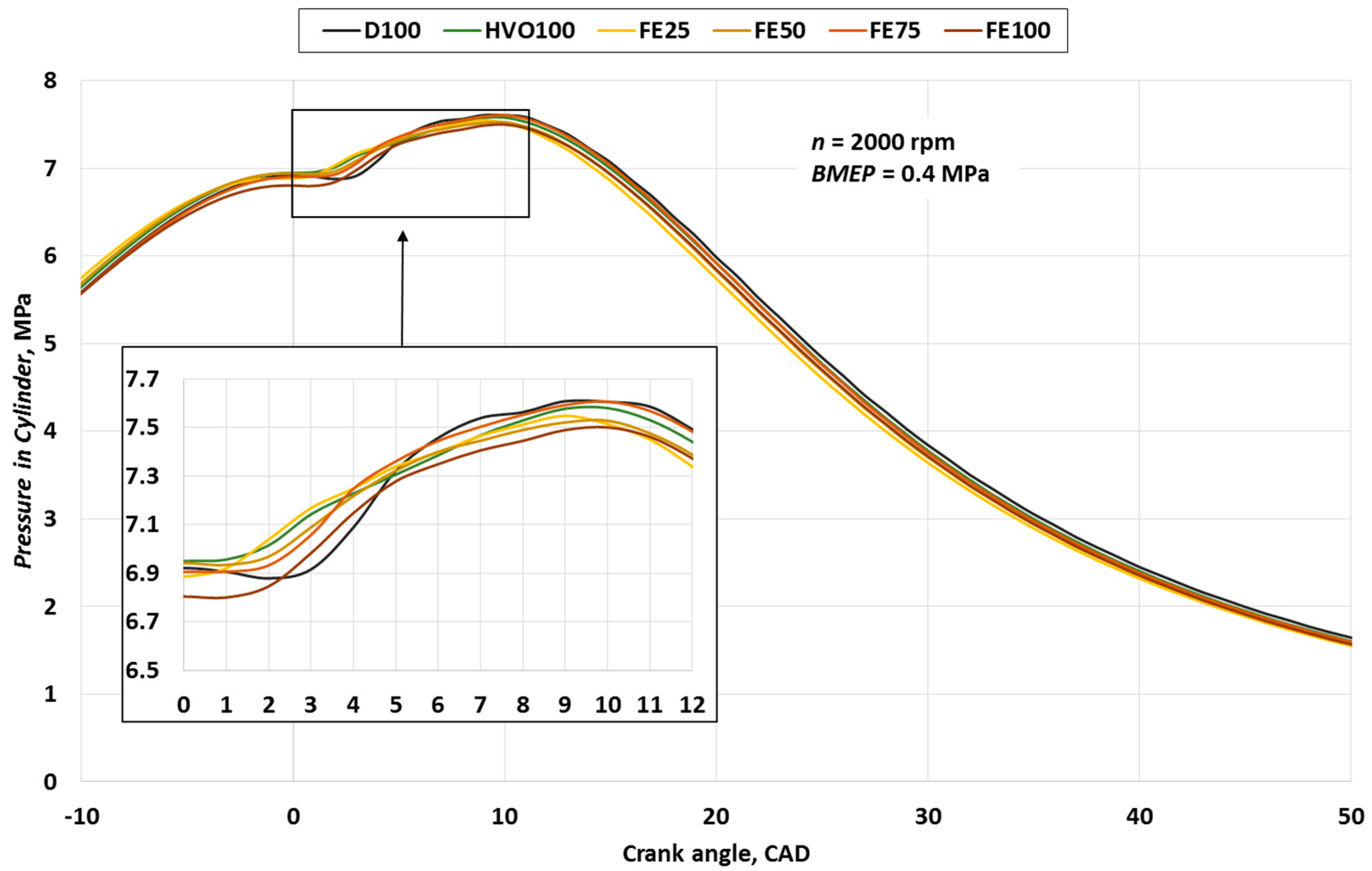
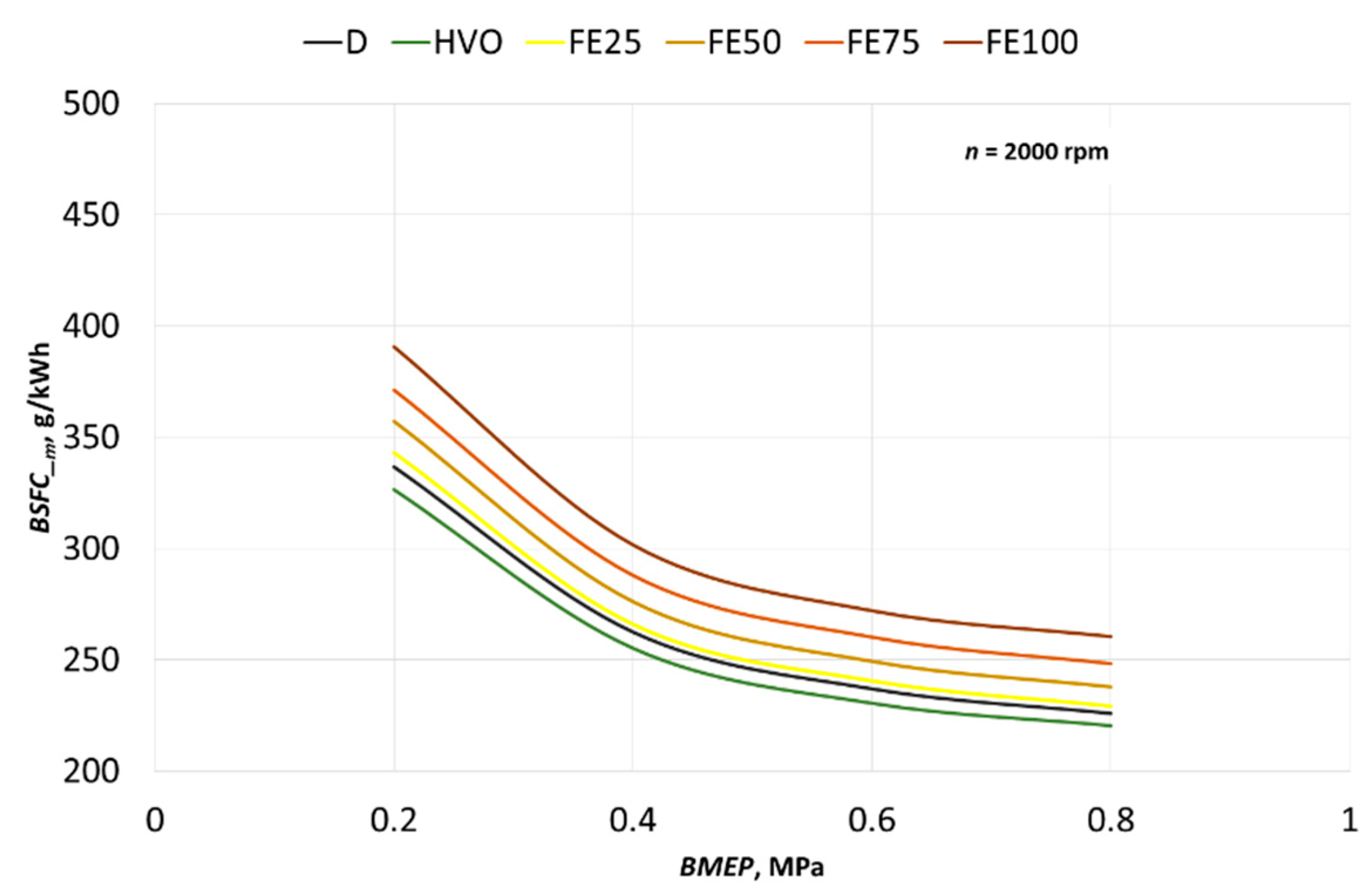

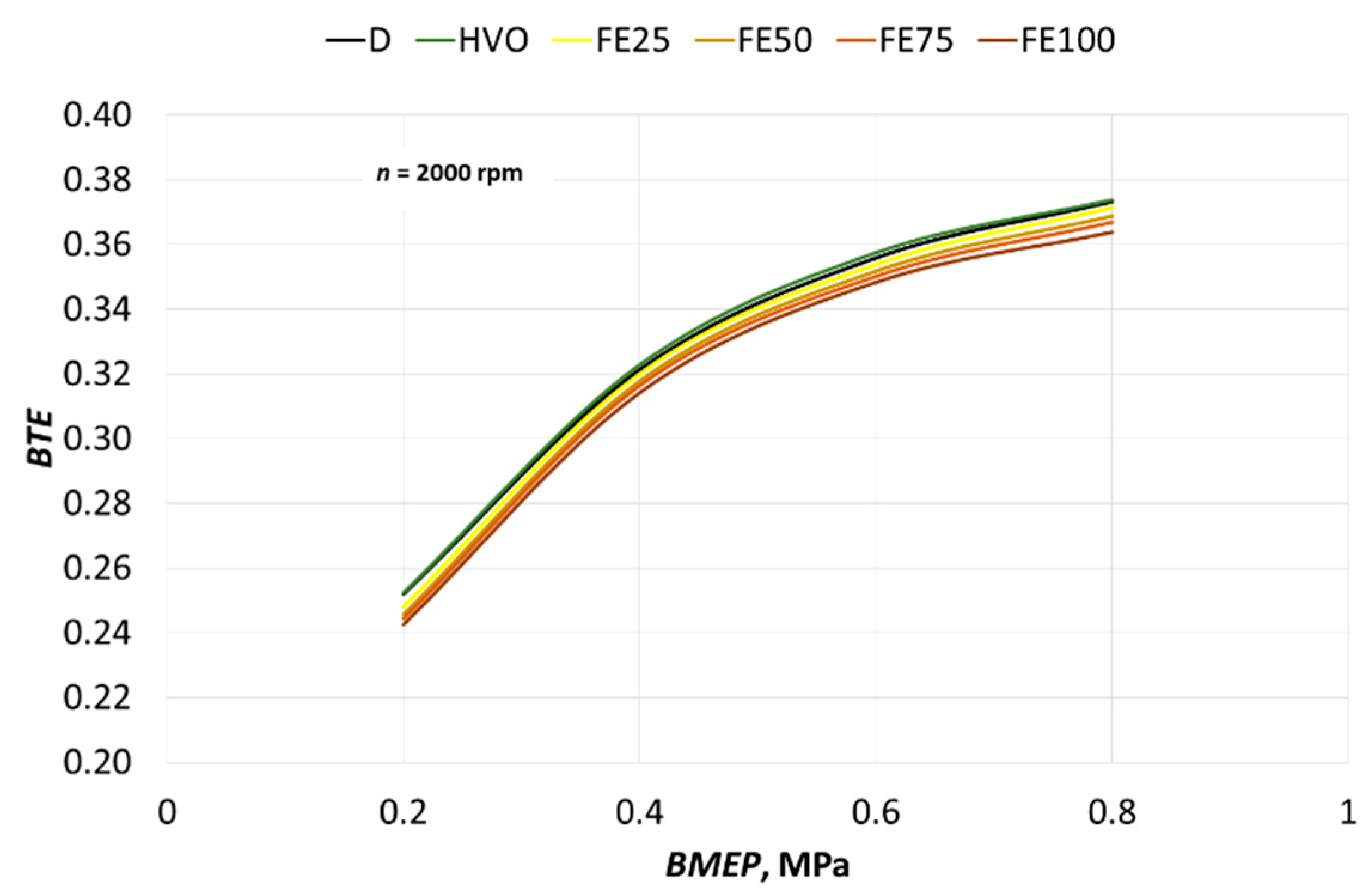

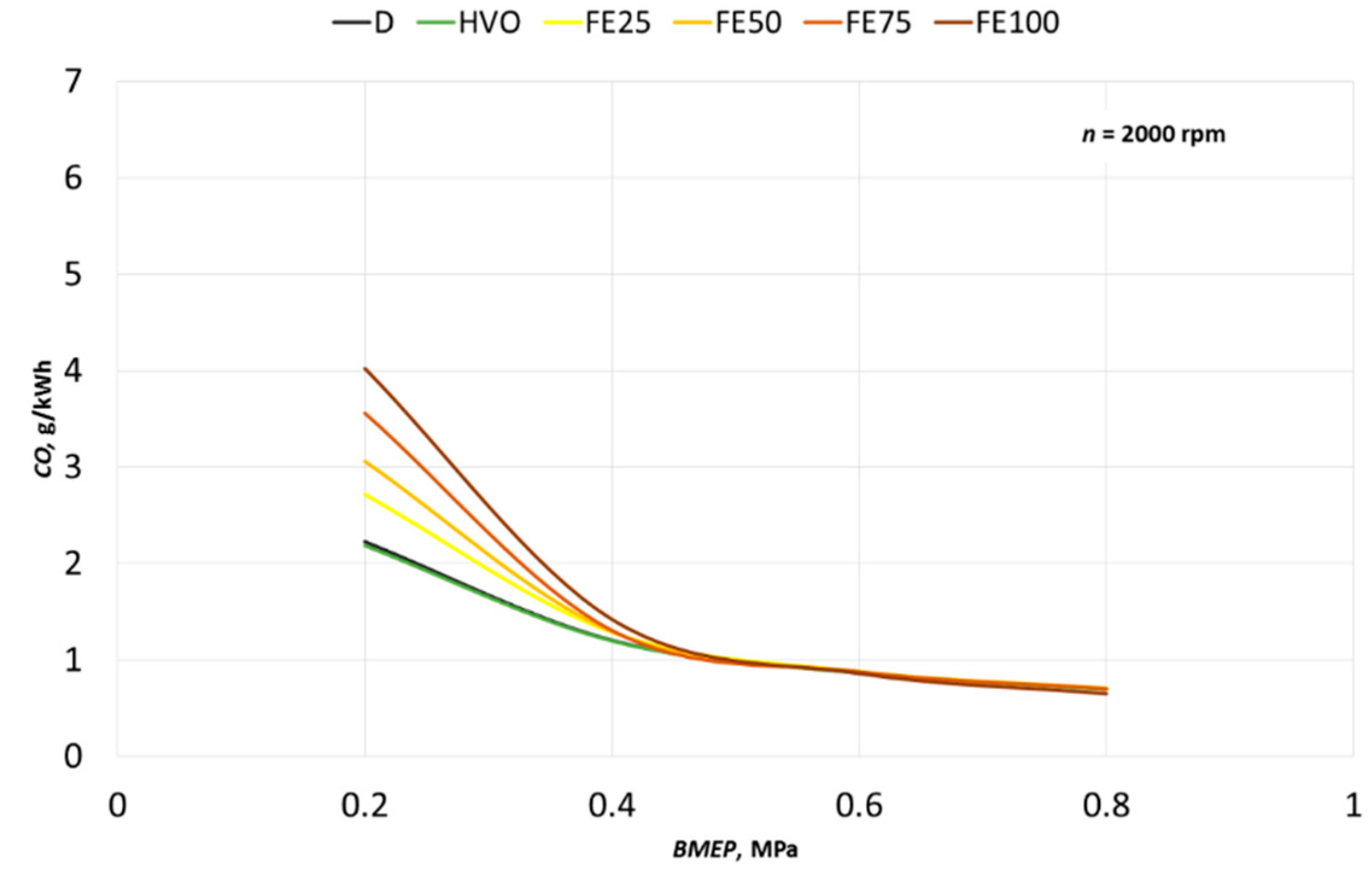
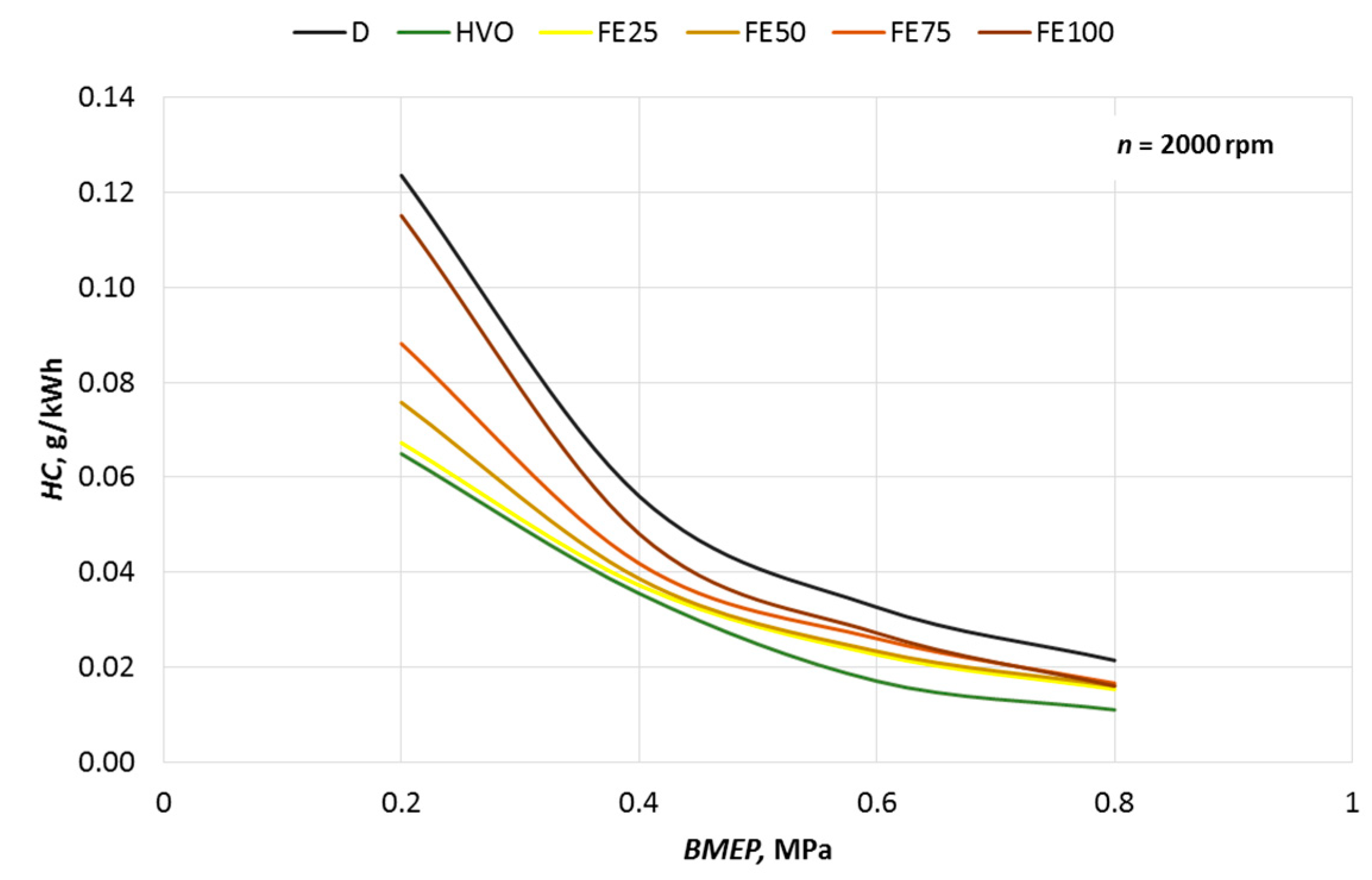
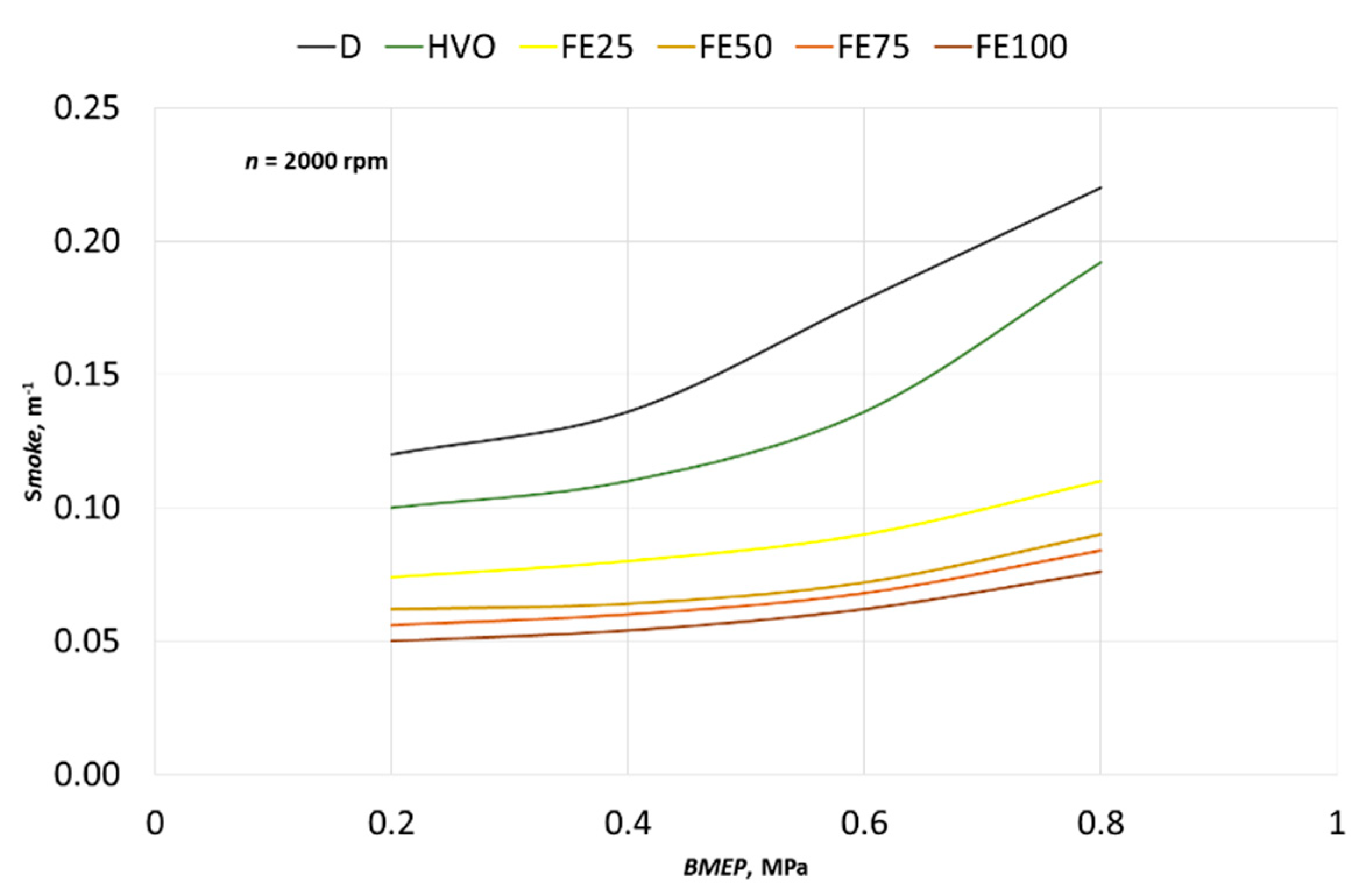
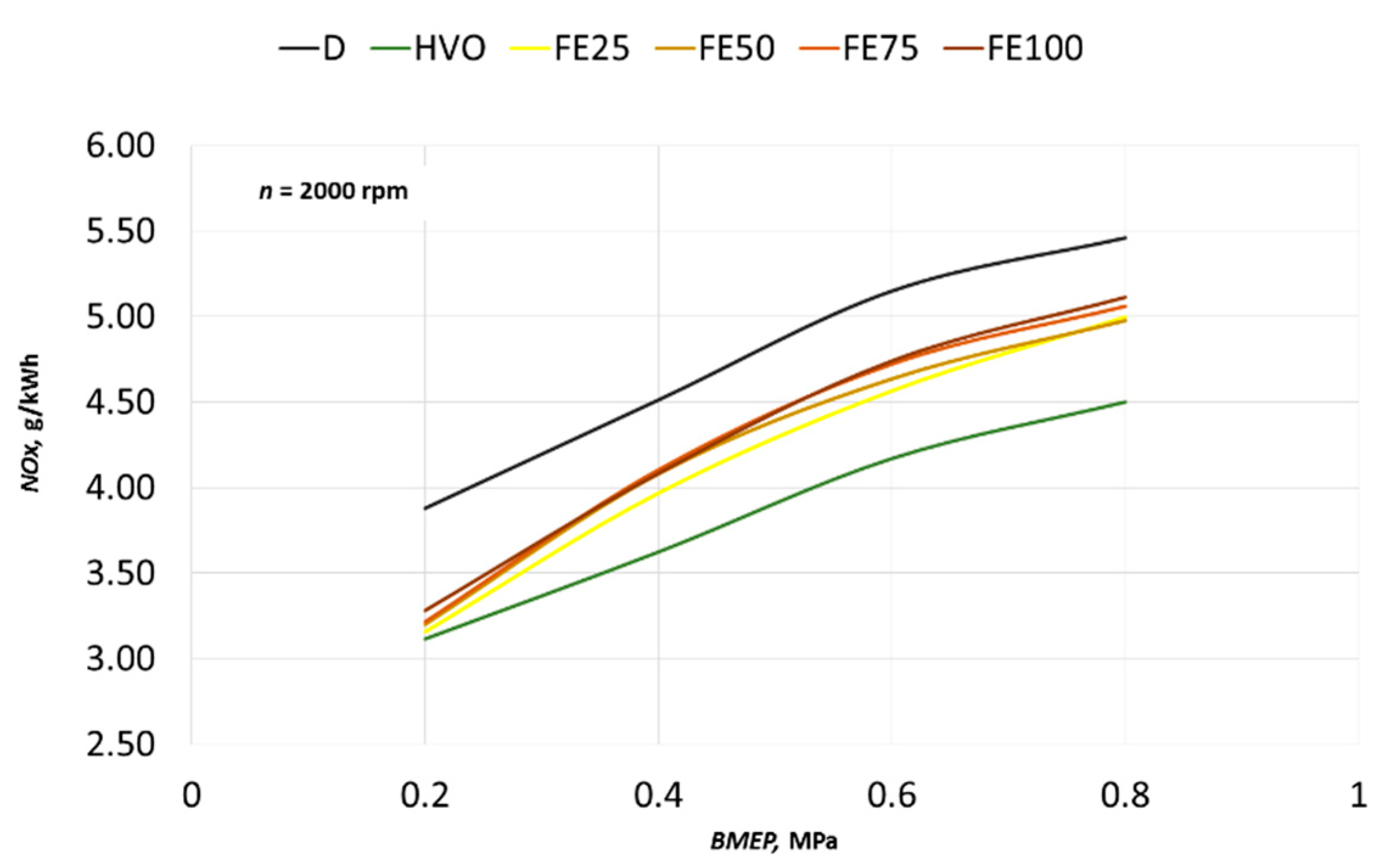
| Sample | D100 | HVO100 | FE25 | FE50 | FE75 | FE100 |
|---|---|---|---|---|---|---|
| Density at 15 °C [kg/m3] | 823.00 | 776.00 | 800.30 | 824.60 | 848.90 | 873.20 |
| Viscosity at 40 °C [mm2/s] | 3.5 | 2.9 | 3.2 | 3.4 | 3.9 | 4.3 |
| Sulphur content [mg/kg] | 7.25 | 4.16 | 4.12 | 4.27 | 4.37 | 5.41 |
| Water content [mg/kg] | 85 | 20 | 120 | 150 | 400 | 460 |
| Flash point, °C | 45 | 55 | 82 | 109 | 136 | 163 |
| Hydrogen, % | 0.1300 | 0.1520 | 0.1460 | 0.1400 | 0.1340 | 0.1280 |
| Carbon, % | 0.8700 | 0.8480 | 0.8233 | 0.7985 | 0.7738 | 0.7490 |
| Oxygen, % | 0.0000 | 0.0000 | 0.0308 | 0.0615 | 0.0923 | 0.1230 |
| C/H | 6,7% | 5.7% | 5.6% | 5.7% | 5.8% | 5.8% |
| Lower Heating Value (LHV) [mg/kg] | 42.70 | 43.70 | 42.30 | 41.05 | 39.53 | 38.00 |
| Cetane number | 45 | 76.89 | 69.95 | 64.52 | 59.41 | 58 |
| General Informations | 1.9 TDI Diesel Engine |
|---|---|
| Number of cylinders | 4/In-Line |
| Bore | 79.5 mm |
| Stroke | 95.5 mm |
| Displacement | 1896 cm3 |
| Compression ratio | 19.5 |
| Maximum torque | 180 Nm/2000–2500 rpm |
| Maximum power | 66 kW/4000 rpm |
| Combustion chamber | Direct injection |
| Nozzle opening pressure | 190 bar |
| Fuel injection | Single |
| Cooling | Liquid |
| Measuring Points | 1 | 2 | 3 | 4 |
|---|---|---|---|---|
| Engine speed n, rpm | 2000 | 2000 | 2000 | 2000 |
| Engine load MB, Nm | 30 | 60 | 90 | 120 |
| BMEP, MPa | 0.2 | 0.4 | 0.6 | 0.8 |
| SOI, CAD | −4 | −5 | −6 | −7 |
Publisher’s Note: MDPI stays neutral with regard to jurisdictional claims in published maps and institutional affiliations. |
© 2021 by the authors. Licensee MDPI, Basel, Switzerland. This article is an open access article distributed under the terms and conditions of the Creative Commons Attribution (CC BY) license (https://creativecommons.org/licenses/by/4.0/).
Share and Cite
Shepel, O.; Matijošius, J.; Rimkus, A.; Duda, K.; Mikulski, M. Research of Parameters of a Compression Ignition Engine Using Various Fuel Mixtures of Hydrotreated Vegetable Oil (HVO) and Fatty Acid Esters (FAE). Energies 2021, 14, 3077. https://doi.org/10.3390/en14113077
Shepel O, Matijošius J, Rimkus A, Duda K, Mikulski M. Research of Parameters of a Compression Ignition Engine Using Various Fuel Mixtures of Hydrotreated Vegetable Oil (HVO) and Fatty Acid Esters (FAE). Energies. 2021; 14(11):3077. https://doi.org/10.3390/en14113077
Chicago/Turabian StyleShepel, Oleksandra, Jonas Matijošius, Alfredas Rimkus, Kamil Duda, and Maciej Mikulski. 2021. "Research of Parameters of a Compression Ignition Engine Using Various Fuel Mixtures of Hydrotreated Vegetable Oil (HVO) and Fatty Acid Esters (FAE)" Energies 14, no. 11: 3077. https://doi.org/10.3390/en14113077
APA StyleShepel, O., Matijošius, J., Rimkus, A., Duda, K., & Mikulski, M. (2021). Research of Parameters of a Compression Ignition Engine Using Various Fuel Mixtures of Hydrotreated Vegetable Oil (HVO) and Fatty Acid Esters (FAE). Energies, 14(11), 3077. https://doi.org/10.3390/en14113077







